Enniskillen
Enniskillen (/ˌɛnɪsˈkɪlən/, from Irish: Inis Ceithleann[2] [ˈɪnʲɪʃ ˈcɛlʲən̪ˠ], 'Ceithlenn's island') is a town and civil parish in County Fermanagh, Northern Ireland. It is located almost exactly in the centre of the county, between the Upper and Lower sections of Lough Erne. It had a population of 13,823 at the 2011 Census.[3] It was the seat of local government for the former Fermanagh District Council, and is the county town of Fermanagh as well as its largest town.
| Enniskillen | |
|---|---|
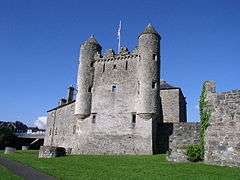 Enniskillen castle | |
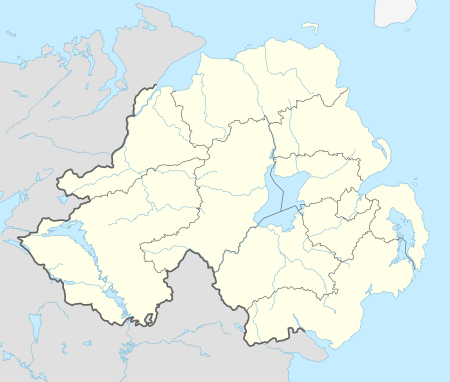 Enniskillen Location within Northern Ireland | |
| Population | 13,823 (2011 Census) |
| Irish grid reference | H240440 |
| • Belfast | 88 miles (142 km) |
| District | |
| County | |
| Country | Northern Ireland |
| Sovereign state | United Kingdom |
| Post town | ENNISKILLEN |
| Postcode district | BT74, BT92-94 |
| Dialling code | 028 |
| Police | Northern Ireland |
| Fire | Northern Ireland |
| Ambulance | Northern Ireland |
| UK Parliament | |
| NI Assembly | |
| Website | www.enniskillen.com |
Toponymy
The town's name comes from the Irish: Inis Ceithleann. This refers to Cethlenn, a figure in Irish mythology who may have been a goddess. Local legend has it that Cethlenn was wounded in battle by an arrow and attempted to swim across the River Erne, which surrounds the island, but she never reached the other side, so the island was named in reference to her. It has been anglicised many ways over the centuries – Iniskellen, Iniskellin, Iniskillin, Iniskillen, Inishkellen, Inishkellin, Inishkillin, Inishkillen and so on.[2]
History
.jpg)
The town's oldest building is Enniskillen Castle, built by Hugh (Maguire) the Hospitable who died in 1428.[4] An earthwork, the Skonce on the shore of Lough Erne, may be the remains of an earlier motte. The castle was the stronghold of the junior branch of the Maguires.[5] The first watergate was built around 1580 by Cú Chonnacht Maguire, though subsequent lowering of the level of the lough has left it without water. The strategic position of the castle made its capture important for the English in 1593, to support their plans for the control of Ulster. The castle was besieged three times in 1594–95. The English, led by a Captain Dowdall, captured it in February 1594. Maguire then laid siege to it, and defeated a relieving force at the Battle of the Ford of the Biscuits at Drumane Bridge on the Arney River. Although the defenders were relieved, Maguire gained possession of the castle from 1595 to 1598 and it was not finally captured by the English until 1607.
This was part of a wider campaign to bring the province of Ulster under English control; the final capture of Enniskillen Castle in 1607 was followed by the Plantation of Ulster, during which the lands of the native Irish were seized and handed over to planters loyal to the English Crown. The Maguires were supplanted by William Cole, originally from Devon, who was appointed by James I to build an English settlement there.
Captain Cole was installed as Constable and strengthened the castle wall and built a "fair house" on the old foundation as the centre point of the county town. The first Protestant parish church was erected on the hilltop in 1627. The Royal Free School of Fermanagh was moved onto the island in 1643. The first bridges were drawbridges; permanent bridges were not installed before 1688.
By 1689 the town had grown significantly. During the conflict which resulted from the ousting of King James II by his Protestant rival, William III, Enniskillen and Derry were the focus of Williamite resistance in Ireland, including the nearby Battle of Newtownbutler.[6]
Enniskillen and Derry were the two garrisons in Ulster that were not wholly loyal to James II, and it was the last town to fall before the siege of Derry. As a direct result of this conflict, Enniskillen developed not only as a market town but also as a garrison, which became home to two regiments.
The current site of Fermanagh College (now part of the South West College) was the former Enniskillen Gaol. Many people were tried and hanged in the square during the times of public execution. Part of the old Gaol is still used by the college.
Military history
Enniskillen is the site of the foundation of two British Army regiments:
- Royal Inniskilling Fusiliers
- The Inniskillings (6th Dragoons)
The town's name (with the archaic spelling) continues to form part of the title to The Royal Irish Regiment (27th (Inniskilling) 83rd and 87th and Ulster Defence Regiment). Enniskillen Castle features on the cap badge of both regiments.
The Troubles
Enniskillen was the site of several events during The Troubles, the most notable being the Remembrance Day bombing in which 11 people were killed. Bill Clinton opened the Clinton centre in 2002 on the site of the bombing. The Provisional Irish Republican Army claimed responsibility for the attack.
Alleged sexual abuse and assault
In 2019, at least nine men reported to the police and the press and said in public forums that, in the 1980s and 90s, when they were children, they were repeatedly molested and raped by a paedophile ring of at least 20 men in the Enniskillen area.[7][8][9][10] Investigations are continuing.
Miscellaneous
- The Enniskillen Dragoon is a famous Irish folk song associated with the Inniskilling Dragoons Regiment. Tommy Makem wrote additional verses and re-named the song Fare Thee Well, Enniskillen.
- The Chieftains sing a song that mentions Enniskillen titled "North Amerikay".
- Jim Kerr of Simple Minds was so moved by the horror of the Enniskillen bombing in 1987 that he wrote new words to the traditional folk song "She Moved Through The Fair" and the group recorded it with the name "Belfast Child". The recording reached No. 1 in the UK Charts, Ireland and several other countries in 1989. The single was taken from the album Street Fighting Years; the single version was also published with the title "Ballad of the Streets". The video to the song was shot in black and white and displays poignant footage of children and the destruction of the bombing. Similarly, U2 held a concert the same day as the bombing; during a performance of their song "Sunday Bloody Sunday", singer Bono passionately condemned the bombing, stating "fuck the revolution" in his mid-song speech. The footage is included in U2's rockumentary Rattle and Hum.[11]
- Neil Hannon also mentions Enniskillen in his song "Sunrise".
- Bill Fay also mentions Enniskillen in his song In Human Hands
- The Irish language novel Mo Dhá Mhicí by Séamus Mac Annaidh is set in Enniskillen.
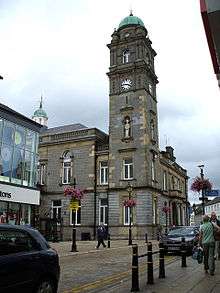
Demography
On Census day (27 March 2011) there were 13,823 people living in Enniskillen (5,733 households), accounting for 0.76% of the NI total[3] and representing an increase of 1.6% on the Census 2001 population of 13,599.[12] Of these:
- 19.76% were aged under 16 years and 15.59% were aged 65 and over;
- 51.80% of the usually resident population were female and 48.20% were male;
- 61.62% belong to or were brought up in the Catholic religion and 33.55% belong to or were brought up in a 'Protestant and Other Christian (including Christian related)' religion;
- 35.59% indicated that they had a British national identity, 33.77% had an Irish national identity and 30.35% had a Northern Irish national identity (respondents could indicate more than one national identity);
- 39 years was the average (median) age of the population;
- 13.03% had some knowledge of Irish (Gaelic) and 3.65% had some knowledge of Ulster-Scots.
Climate
Enniskillen has a maritime climate with a narrow range of temperatures and rainfall. The nearest official Met Office weather station for which online records are available is at Lough Navar Forest,[13] about 8 1⁄2 mi (14 km) northwest of Enniskillen. Data has also more recently been collected from Enniskillen/St Angelo Airport, under 4 mi (6 km) north of the town centre, which should in time give a more accurate representation of the climate of the Enniskillen area.
The absolute maximum temperature is 29.8 °C (85.6 °F), recorded during July 2006.[14] In an 'average' year, the warmest day is 25.5 °C (77.9 °F)[15] and only 2.4 days[16] a year should rise to 25.1 °C (77.2 °F) or above. The respective absolute maximum for St Angelo is 29.4 °C (84.9 °F)[17]
The absolute minimum temperature is −12.9 °C (8.8 °F), recorded during January 1984.[18] In an 'average' year, the coldest night should fall to −8.2 °C (17.2 °F). Lough Navar is a frosty location, with some 76 air frosts recorded in a typical year.[18] It is likely that Enniskillen town centre is significantly less frosty than this. The absolute minimum at St Angelo is −14.5 °C (5.9 °F), reported during the record cold month of December 2010.[18]
The warmest month on record at St Angelo was August 1995 with a mean temperature of 18.8 °C (65.8 °F)[19] (mean maximum 23.3 °C (73.9 °F), mean minimum 12.9 °C (55.2 °F), while the coldest month was December 2010, with a mean temperature of −1.8 °C (28.8 °F)[20] (mean maximum 2.9 °C (37.2 °F), mean minimum −5.9 °C (21.4 °F).
Rainfall is high, averaging over 1500 mm. 212 days of the year report at least 1 mm of precipitation, ranging from 15 days during April, May and June, to 20 days in October, November, December, January and March.
The Köppen climate classification subtype for this climate is "Cfb" (Marine West Coast Climate/Oceanic climate).[21]
| Climate data for Lough Navar Forest 126m asl 1971–2000, extremes 1960– (Weather station 8.5 miles (14 km) North West of Enniskillen) | |||||||||||||
|---|---|---|---|---|---|---|---|---|---|---|---|---|---|
| Month | Jan | Feb | Mar | Apr | May | Jun | Jul | Aug | Sep | Oct | Nov | Dec | Year |
| Record high °C (°F) | 13.0 (55.4) |
15.4 (59.7) |
20.0 (68.0) |
23.2 (73.8) |
26.1 (79.0) |
28.8 (83.8) |
29.8 (85.6) |
28.0 (82.4) |
23.2 (73.8) |
19.5 (67.1) |
16.8 (62.2) |
13.8 (56.8) |
29.8 (85.6) |
| Average high °C (°F) | 6.4 (43.5) |
7.0 (44.6) |
8.9 (48.0) |
11.5 (52.7) |
14.5 (58.1) |
16.6 (61.9) |
18.3 (64.9) |
18.1 (64.6) |
15.6 (60.1) |
12.2 (54.0) |
8.8 (47.8) |
7.0 (44.6) |
12.1 (53.7) |
| Average low °C (°F) | 0.3 (32.5) |
0.5 (32.9) |
1.4 (34.5) |
2.2 (36.0) |
4.3 (39.7) |
7.4 (45.3) |
9.7 (49.5) |
9.2 (48.6) |
7.1 (44.8) |
5.1 (41.2) |
2.1 (35.8) |
1.2 (34.2) |
4.2 (39.6) |
| Record low °C (°F) | −12.9 (8.8) |
−10.5 (13.1) |
−11.6 (11.1) |
−7.3 (18.9) |
−4.4 (24.1) |
−2.4 (27.7) |
1.0 (33.8) |
0.2 (32.4) |
−2.6 (27.3) |
−7.2 (19.0) |
−8.4 (16.9) |
−12.8 (9.0) |
−12.9 (8.8) |
| Average precipitation mm (inches) | 163.38 (6.43) |
123.19 (4.85) |
136.81 (5.39) |
93.85 (3.69) |
87.4 (3.44) |
93.39 (3.68) |
101.37 (3.99) |
117.45 (4.62) |
123.94 (4.88) |
155.7 (6.13) |
157.26 (6.19) |
169.1 (6.66) |
1,522.84 (59.95) |
| Source 1: YR.NO[22] | |||||||||||||
| Source 2: Royal Netherlands Meteorological Institute[23] | |||||||||||||
Places of interest
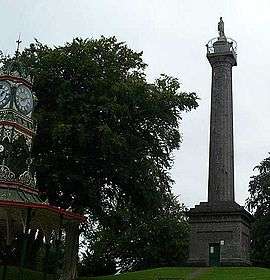
- Ardhowen Theatre
- Castle Coole
- Cole's Monument
- Enniskillen Castle
- Mount Lourdes Grammar School
- Portora Royal School (Now Enniskillen Royal Grammar School)
- Portora Castle
- St. Macartin's Cathedral
- St. Michael's College (Enniskillen)
- The Clinton Centre
- The Regimental Museum of the Inniskilling Regiment
- The Round O
- The Marble Arch Caves
- Cuilcagh Mountain Global Geo-Park
- Monea Castle
- Lough Navar and the Cliffs of Magho
Sports
Football
The town has two association football teams called Enniskillen Rangers and Enniskillen Town United F.C.
Enniskillen Rangers are the current holders of the Irish Junior Cup, defeating Hill Street 5-1 on Monday, 1 May 2017. The match was played at the National Football Stadium at Windsor Park in Belfast.[24] They play their home games at the Ball Range.[25]
Enniskillen Rangers have several notable former players including Sandy Fulton and Jim Cleary.
Enniskillen Town United F.C. currently play in the Fermanagh & Western 1st Division. Their most notable former player is Michael McGovern who currently plays for Norwich City F.C. At the moment, Enniskillen Town play their home games at The Lakeland Forum playing fields in Enniskillen.
Rugby
Enniskillen Rugby Football Club was founded in 1925 and plays their home games at Mullaghmeen. The club currently fields 4 senior men's teams, a senior ladies teams, a range of male and female youth teams, a vibrant mini section and a disability tag team called The Enniskillen Elks. Enniskillen XV won the Ulster Towns Cup in the 2018/19 season, defeating Ballyclare 19-0. The team currently play in Kukri Ulster Rugby Championship Division 1.[26]
The rugby club was formed on 28 August 1925, when 37 attended a meeting in Enniskillen Town Hall. The name Enniskillen Rugby Club was agreed and the club adopted the rules of Dublin University. The first match was played on 30 September 1925 against Ballyshannon in County Donegal.[27]
Gaelic Football
Enniskillen Gaels are a Gaelic Athletic Association club founded in 1927. They play their home games at Brewster Park, Enniskillen.
International events
Enniskillen was the venue of the 39th G8 summit which was held on 17 and 18 June 2013. It was held at the Lough Erne Resort, a five-star hotel and golf resort on the shore of Lough Erne. The gathering was the biggest international diplomatic gathering ever held in Northern Ireland. Among the G8 leaders who attended were British Prime Minister David Cameron, United States President Barack Obama, German Chancellor Angela Merkel, and Russian President Vladimir Putin.[28]
In the past, Enniskillen has hosted an array of international events, most notably stages of the World Waterski World Cup, annually from 2005 to 2007 at the Broadmeadow.[29] Despite its success, Enniskillen was not chosen as a World Cup Stop for 2008.
In January 2009, Enniskillen hosted the ceremonial start of Rally Ireland 2009, the first stage of the WRC FIA World Rally Championship 2009 Calendar.[30]
Enniskillen has hosted the Happy Days arts festival since 2012, which celebrates "the work and influence of Nobel Prize-winning writer Samuel Beckett" and is the "first annual, international, multi-arts festival to be held in Northern Ireland since the launch of the Ulster Bank Belfast Festival at Queen’s in 1962".[31]
Notable natives and residents
- Samuel Beckett, playwright, educated at Portora Royal School
- Eric Bell, recipient of the Victoria Cross
- Denis Burkitt, FRS, surgeon and epidemiologist
- Declan Burns, Irish kayaking athlete, three-time Irish Olympic representative and former World Superstars runner-up
- Roy Carroll, goalkeeper who plays for Linfield F.C. and who has been capped by Northern Ireland
- Harry Chatton, football player, from the 1920s and 1930s, who was a dual international for both the IFA and FAI Irish international teams
- Jim Cleary, former Glentoran footballer and member of Northern Ireland's 1982 World Cup squad
- Edward Cooney, evangelist and early leader of the Cooneyite and Go-Preacher sects, educated at Portora Royal School
- Charles Duff, Irish author of books on language learning and other subjects
- Adrian Dunbar, actor, born and brought up in Enniskillen
- William Emerson, football player who won 11 caps for Ireland between 1919 and 1923
- Claire Falconer, actress and painter
- Gordon Ferris, Northern Irish former heavyweight boxer who was both Irish and British champion in the early 1980s
- Nial Fulton, film and television producer, educated at Portora Royal School
- James Gamble, co-founder of Procter & Gamble, educated at Portora Royal School
- Neil Hannon, lead singer/composer of the pop band The Divine Comedy, educated at Portora Royal School
- Henry Hartigan, recipient of the Victoria Cross
- Frank Hoy, professional wrestler, was born in the town
- Frederick Irwin, (Lieutenant-Colonel) (1788 – 31 March 1860) was acting Governor of Western Australia from 1847 to 1848
- Edward Kernan, a Roman Catholic bishop
- Robert Kerr, Olympic 100m gold medalist in the 1908 Olympics for Canada
- Kyle Lafferty, striker, professional football player for Rangers and Northern Ireland international
- Charles Lawson, most notable for playing Jim McDonald in Coronation Street
- Andrew Little, professional football player for Dumbarton and Northern Ireland international, educated at Portora Royal School
- Henry Francis Lyte, hymn composer, most notably of "Abide With Me", educated at Portora Royal School
- David McCann, author of children's books
- John McElroy (1782–1877), Jesuit priest, founder of Boston College
- Michael McGovern, Northern Ireland international goalkeeper, currently with Norwich City F.C.
- James McGuire, recipient of the Victoria Cross
- Lisa McHugh, country music singer; born in Glasgow, Scotland, she moved to Enniskillen as an adult.
- Fearghal McKinney, journalist, former UTV broadcaster and member of the Northern Ireland Assembly
- Nigel McLoughlin, poet, editor of Iota poetry journal and Professor of Creativity and Poetics, University of Gloucestershire
- Ciarán McMenamin, television actor
- Gavin Noble, Irish international triathlete, educated at Portora Royal School
- George Nurse, recipient of the Victoria Cross
- Frank Ormsby, poet
- Seán Quinn, entrepreneur and formerly Ireland's richest man (originally from Derrylin)
- David Robinson, photographer and publisher, educated at Portora Royal School
- Dick Rowley, football player who won six caps for Ireland between 1929 and 1931
- William Scott, artist
- Mick Softley singer and songwriter for Bob Dylan and Donovan, lived in the town at the time of his death
- Joan Trimble, pianist and composer
- Gerald Grosvenor, 6th Duke of Westminster, brought up at the family's estate at Ely Lodge
- Oscar Wilde, satirist and playwright, educated at Portora Royal School
- Gordon Wilson, peace campaigner and Irish senator
- Ron Wilson, a news anchor with Network Ten in Australia
Education
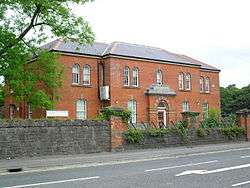
There are numerous schools and colleges in and around the Enniskillen area, from primary level to secondary level, including some further education colleges such as the technical college.
Primary level
- Erne Integrated Primary school
- Model primary school
- Holy Trinity Primary School
- Jones Memorial Primary School
- Mullnaskea Primary School
Secondary level
- Erne Integrated College
- Devenish College
- Enniskillen Royal Grammar School
- Mount Lourdes Enniskillen; convent girls grammar school
- St Michael's College; boys grammar school
- St Fanchea's College
- St Joseph's College
Colleges
- Enniskillen Campus of the College of Agriculture, Food and Rural Enterprise (CAFRE)
- Enniskillen Campus South West College
Transport
Rail – historic
Railway lines from Enniskillen railway station linked the town with Derry from 1854, Dundalk from 1861, Bundoran from 1868 and Sligo from 1882.[32] By 1883 the Great Northern Railway (Ireland) absorbed all the lines except the Sligo, Leitrim and Northern Counties Railway, which remained independent throughout its existence. In October 1957 the Government of Northern Ireland closed the GNR line, which made it impossible for the SL&NCR continue and forced it also to close.[33]
Rail – current
The nearest railway station to Enniskillen is Sligo station which is served by trains to Dublin Connolly and is operated by Iarnród Éireann. The Dublin-Sligo railway line has a two-hourly service run by Iarnród Éireann Official site – Timetables, bookings and operations The connecting bus from Sligo via Manorhamilton to Enniskillen is route 66 operated by Bus Éireann.
Bus
Bus service to Enniskillen is provided by both Ulsterbus and Bus Éireann, from Enniskillen bus station. Number 261, 261b and X261 Goldline buses run from Belfast to Enniskillen. Bus Éireann Route 30 runs from Donegal to Dublin Airport/Dublin City via Enniskillen.
Air
Enniskillen has a World War II-era airport, Enniskillen/St Angelo Airport. The airport had scheduled flights in the past but now serves mainly private traffic.
Twinning
Enniskillen was originally twinned with Brackwede – a Bielefeld suburb – where the Inniskilling Dragoon Guards were stationed in the late 1950s when the twinning was initiated; however, this suburb was incorporated into Stadt Bielefeld in 1973, the city with which Enniskillen is now officially twinned.[34][35]
Though the twinning arrangements are still operational, at a meeting of the Regeneration and Community Committee, in February 2018, it was agreed that the twinning arrangements would be formally terminated at the end of the Council term in June 2018. However, Fermanagh and Omagh District Council still have plans to send representatives to Brackwede for the 60th anniversary celebrations of the twinning. Therefore, the future of the twinning is now somewhat unclear.[36]
See also
References
- "Home" (PDF).
- "Inis Ceithleann/Enniskillen". Placenames Database of Ireland (logainm.ie). Department of Culture, Heritage and the Gaeltacht and Dublin City University. Retrieved 7 July 2020.
- "Census 2011 Population Statistics for Enniskillen Settlement". Northern Ireland Statistics and Research Agency. Retrieved 5 March 2018.
- Mary Rogers (1982). Prospect of Fermanagh. Watergate Press, Enniskillen.
- "The Maguires of Fermanagh". www.libraryireland.com.
- Witherow, Thomas. "The Defence of Enniskillen". Derry and Enniskillen in the Year 1689. Library Ireland. Retrieved 24 May 2012.
- Grandjean, Stephen Dempster and Guy (26 November 2019). "Victim of alleged paedophile ring speaks out". Retrieved 26 November 2019.
- "Police unit to examine historic sex abuse". 3 May 2019. Retrieved 26 November 2019.
- "Public meeting in Enniskillen hears from alleged sex abuse victims". Impartial Reporter. Retrieved 26 November 2019.
- Edwards, Rodney. "Child sex abuse in Fermanagh was an 'open secret', claim victims". The Irish Times. Retrieved 26 November 2019.
- U2, Phil Joanou (director) (1999). U2: Rattle and Hum (DVD). Paramount.
- "Census 2001 Usually Resident Population: KS01 (Settlements) - Table view". Northern Ireland Statistics and Research Agency (NISRA). p. 4. Retrieved 10 August 2019.
- "Station Locations". MetOffice.
- "2006 Maximum". Retrieved 20 September 2011.
- "71-00 Mean Warmest Day". Retrieved 20 September 2011.
- "71-00 >25c days". Retrieved 20 September 2011.
- "2006 Maximum". Retrieved 20 September 2011.
- "2003 Sunshine". Retrieved 20 September 2011.
- "August 1995". Retrieved 20 September 2011.
- "December 2010". Retrieved 20 September 2011.
- "Enniskillen, Northern Ireland Köppen Climate Classification (Weatherbase)".
- "1971–2000 averages". Met Office. September 2011. Retrieved 16 September 2011.
- "Climate Normals 1971–2000". Royal Netherlands Meteorological Institute. Retrieved 20 September 2011.
- "Enniskillen Rangers lift the Junior Cup 2017!" – via www.youtube.com.
- "FOOTBALL REVIEW: Kerr steers Rangers to Junior Cup glory". Impartial Reporter. 2 January 2018. Retrieved 7 September 2019.
- "Home Page - Enniskillen Rugby Football Club". www.enniskillenrfc.com.
- "Articles - Enniskillen Rugby Football Club". www.enniskillenrfc.com.
- "Tanaiste welcomes announcement that Enniskillen will host the G8 Summit in June 2013". MerrionStreet. Retrieved 30 January 2013.
- "International Water Ski Federation 2007".
- "2009 Rally Ireland Races Into Enniskillen". www.niassembly.gov.uk.
- "Happy Days Enniskillen International Beckett Festival - Festivals - Irish Theatre". www.irishtheatre.ie.
- Hajducki, S. Maxwell (1974). A Railway Atlas of Ireland. Newton Abbott: David & Charles. maps 6, 7, 12. ISBN 0-7153-5167-2.
- Sprinks, N.W. (1970). Sligo, Leitrim and Northern Counties Railway. Billericay: Irish Railway Record Society (London Area).
- "Städtepartnerschaften". www.bielefeld.de (in German). Retrieved 31 January 2018.
- "Fermanagh people help to celebrate twin town's 800th anniversary". The Impartial Reporter. 2 August 2014. Retrieved 31 January 2018.
- "Looks like Auf Wiedersehen to Enniskillen's twin town". The Fermanagh Herald. 1 September 2018.
External links
| Wikimedia Commons has media related to Enniskillen. |
| Wikivoyage has a travel guide for Enniskillen. |
